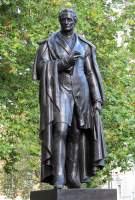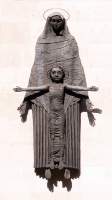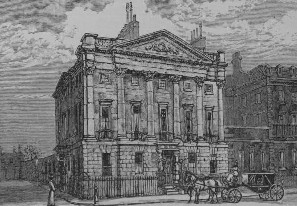
 Lord Bentinck, by Thomas Campbell, and Epstein's Madonna and Child.
Lord Bentinck, by Thomas Campbell, and Epstein's Madonna and Child.

 Lord Bentinck, by Thomas Campbell, and Epstein's Madonna and Child.
Lord Bentinck, by Thomas Campbell, and Epstein's Madonna and Child.
Cavendish Square is behind John Lewis (Oxford Street), and can be the start of a walk via Harley Street, New Cavendish Street and Marylebone High Street through to Baker Street Station or Regents Park.
Cavendish Square is one of the larger squares, ruined by the scheme to move cars around it, but quite pleasant in the centre. There are two noteworthy statues here. A single statue in the Square is of Lord George Frederick Cavendish Bentinck, dating from 1848 - Thomas Campbell was the sculptor -it is a solid piece of work, with strong drapery including a heavy cloak and the treatment of the face being especially noble. To the north of the square, between two Palladian houses, an arch leading to the Theology faculty of the University of London bears Epstein's Madonna and Child (1953), forceful and excellent.
No. 17, formerly the premises of the firm John Brinsmead and Sons, has on its side, facing Wigmore Street, concrete figurative sculptural reliefs by Gilbert Bayes, a sculptor almost contemporary but slightly earlier than Epstein, who made a speciality of decorative work. Much whitewashed, there is a loss of some detail to this work, which includes lively cherubic musicians, and three rather solid allegorical girls.
 Figure by Bayes, 17 Cavendish Square.
Figure by Bayes, 17 Cavendish Square.
Cavendish Square is missing two other statues. It was originally intended, when the Square was laid out, to place a Queen Anne in the centre, but it did not happen. Then, in 1770, an equestrian statue of William, Duke of Cumberland (second son of George II), was placed in the centre spot. This statue, of lead, was removed in 1868 and melted down. The plinth still remains in the centre of the Square, empty until July 2012, when a soap carving similar to the original statue, intended to last for a year, was emplaced upon it - see this page.
 Cavendish Square, looking North, 1820.
Cavendish Square, looking North, 1820.
Edward Harley, Earl of Oxford, owned the land originally, and laid out the Square in 1717. The Duke of Chandos was to have built a great mansion on the north side, but suffered in the South Sea Bubble financial disaster. He did manage to build two houses in the 1720s, one of which survives (much altered) on the corner of Harley Street. Then the centre of the north side was acquired for a proposed Academy for the Dilettanti Society, and although this did not emerge, two Palladian buildings with Corinthian columns were built (1769-72). The picture above shows this side of the Square, with the trees, the two houses built by Harley (the one on the left is the surviving one) and the two central Palladian buildings. Today, these now have between them the arch with the Epstein sculpture.
The Square has an artistic reputation - George Romney lived here - his rival Sir Joshua Reynolds always called him 'the man of Cavendish Square'. He lived in a house built for Francis Cote, another portrait painter, and later Sir Martin Archer Shee PRA lived in the same house - it is no. 32 (though at the time was no. 24). In the house at the corner of Harley Street lived George Watson-Taylor, who was a great collector of paintings until he became bankrupt in 1832. He was born into money, was bequeathed a further enormous fortune, and by squandering it on paintings and other nice things, managed to use up the lot. Sir Robert Peel said of him that 'no man ever bought ridicule at so high a price'.
A brief stroll along Wigmore Street, leading out of the Square to the west, leads to a good example of a Doulton-clad building with sculptural decoration - the Debenhams building - see this page. And eastwards, we come to Portland Place. Or south across Oxford Street leads to Hanover Square.
London sculpture // Sculpture pages
Visits to this page from 23 Nov 2011: 9,111